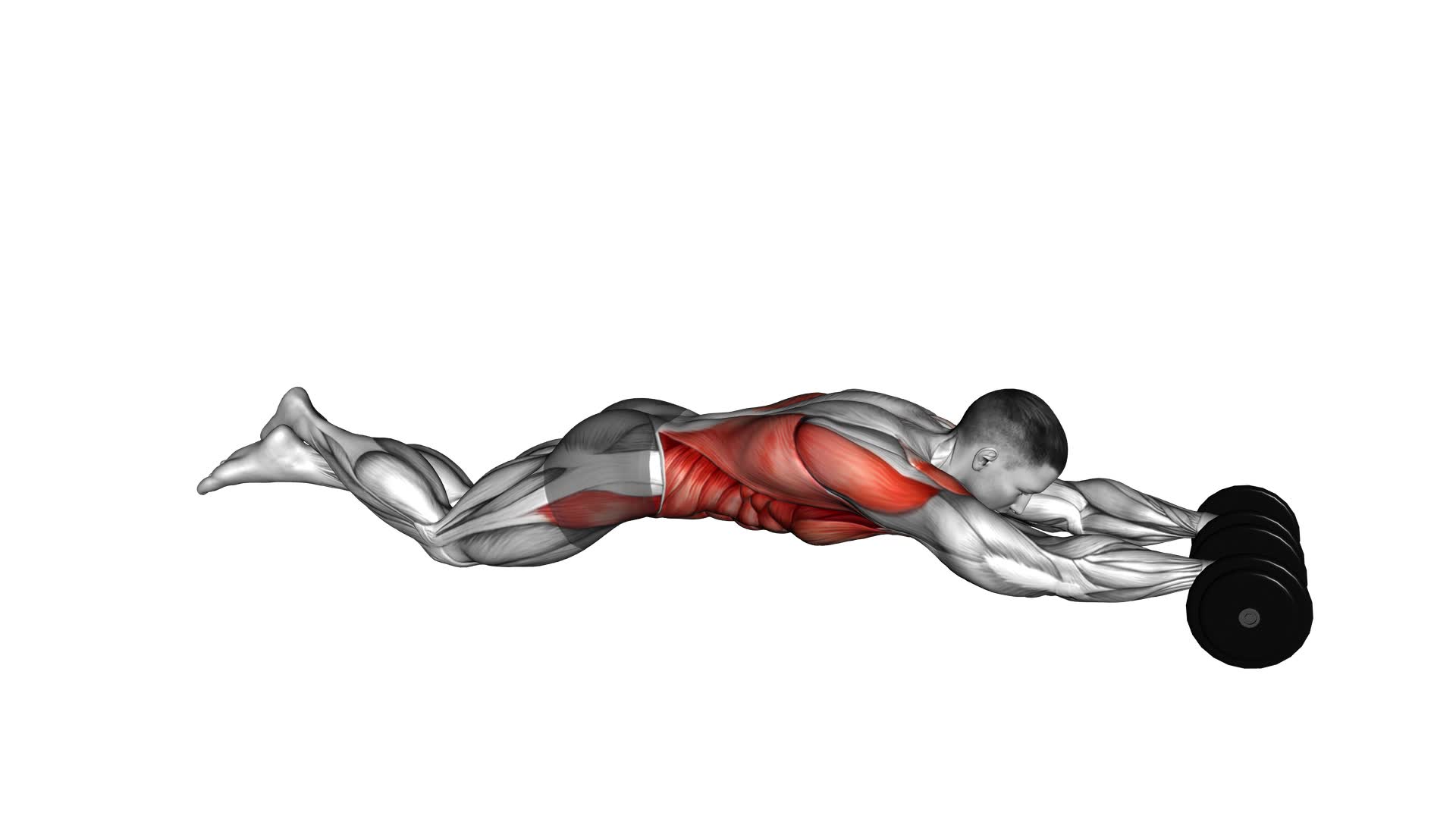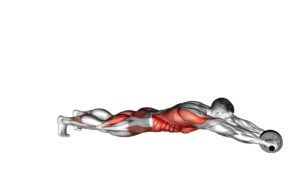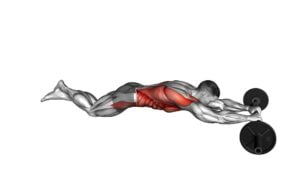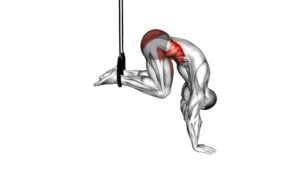Dumbbell Rollout – Video Exercise Guide & Tips

Are you looking to strengthen your core and improve your stability? Look no further than the dumbbell rollout!
Watch This Exercise Video
This exercise targets your abs, back, and shoulders, helping you build a solid foundation. In this video exercise guide, we'll show you the proper form and technique, as well as variations and progressions to keep challenging yourself.
Stay tuned for expert tips and common mistakes to avoid, so you can get the most out of your dumbbell rollout workouts.
Let's roll!
Key Takeaways
- Dumbbell rollouts strengthen core muscles, including abs, obliques, and lower back.
- They improve core stability, posture, and athletic performance.
- Dumbbell rollouts engage multiple muscles, such as rectus abdominis, obliques, and erector spinae.
- They help with everyday activities like lifting and balance, alleviate lower back pain, and improve overall posture.
Benefits of Dumbbell Rollouts
One benefit of dumbbell rollouts is their ability to strengthen your core muscles. Core stability is essential for maintaining proper posture, preventing injuries, and enhancing overall athletic performance. Dumbbell rollouts specifically target your core muscles, including your abs, obliques, and lower back. As you perform the exercise, your core muscles engage to stabilize your body and maintain control throughout the movement.
During dumbbell rollouts, several muscles are activated to support your core stability. The rectus abdominis, also known as the six-pack muscles, contracts to flex your spine and stabilize your pelvis. The obliques, located on the sides of your torso, work to rotate and stabilize your trunk. Additionally, the erector spinae muscles in your lower back help maintain proper spinal alignment and stability.
By regularly incorporating dumbbell rollouts into your workout routine, you can improve your core strength and stability. This not only enhances your performance in other exercises but also helps with everyday activities like lifting heavy objects and maintaining balance. Strong core muscles can alleviate lower back pain and improve your overall posture, leading to better overall health and well-being.
Equipment Needed for Dumbbell Rollouts
To perform dumbbell rollouts effectively, you'll need a few pieces of equipment. The primary piece of equipment needed for dumbbell rollouts is a pair of dumbbells. Choose dumbbells that are appropriate for your fitness level and allow you to maintain proper form throughout the exercise. It's recommended to start with lighter weights and gradually increase as you become stronger and more comfortable with the movement.
In addition to dumbbells, you'll also need an exercise mat or a soft surface to perform the rollouts comfortably. The mat provides cushioning and helps prevent any discomfort or pressure on your wrists and knees. Make sure the surface is stable and non-slip to avoid any accidents during the exercise.
While dumbbells are the most common equipment used for dumbbell rollouts, there are alternative options available. If you don't have access to dumbbells, you can use an ab wheel or a stability ball. These alternatives provide similar benefits to dumbbell rollouts and can be just as effective in targeting your core muscles.
Proper Form and Technique for Dumbbell Rollouts
To perform dumbbell rollouts with proper form and technique, you should focus on maintaining a strong core and controlled movement throughout the exercise.
Start by kneeling on the floor with a dumbbell in each hand, positioned shoulder-width apart. Engage your core by bracing your abs and pulling your shoulders back and down.
Slowly roll the dumbbells forward, extending your arms out in front of you while keeping your back straight. As you roll out, focus on keeping your core tight and your hips stable.
Once you reach your maximum range of motion, pause for a moment, then slowly roll back to the starting position.
This exercise is great for improving stability and increasing core strength. By maintaining proper form and control, you'll activate your abdominal muscles, obliques, and lower back, leading to a stronger and more stable core.
Now, let's explore some progressions and variations of dumbbell rollouts to continue challenging your core muscles.
Progressions and Variations of Dumbbell Rollouts
How can you progress and vary your dumbbell rollouts to continue challenging your core muscles?
Here are four advanced variations and progressions to take your dumbbell rollouts to the next level:
- Single-arm Dumbbell Rollouts: Instead of using both arms simultaneously, try performing the exercise with just one arm. This will increase the demand on your core muscles and improve stability.
- Feet Elevated Dumbbell Rollouts: Elevating your feet on a bench or stability ball will increase the difficulty of the exercise by challenging your core muscles from a different angle. This variation also puts more emphasis on your shoulders and upper body.
- Banded Dumbbell Rollouts: Attach resistance bands to your dumbbells and anchor them to a sturdy object. The bands will add extra resistance and make the exercise more challenging. This variation is great for building strength and stability in your core.
- Ab Wheel Rollouts: If you want to further intensify your dumbbell rollouts, try using an ab wheel instead of dumbbells. The ab wheel requires even more stability and control, making it a challenging progression for your core muscles.
Common Mistakes to Avoid During Dumbbell Rollouts
To perform dumbbell rollouts correctly, make sure you avoid two common mistakes.
Firstly, don't let your elbows go too far out to the sides, as this can strain your shoulders.
Secondly, be sure to engage your core muscles throughout the entire movement to maximize the benefits of the exercise.
Elbows Too Far Out
Avoid extending your elbows too far out during dumbbell rollouts. Proper elbow alignment is crucial for maximizing the effectiveness of this exercise and preventing injury. Here are some important points to keep in mind:
- Maintain a slight bend in your elbows: Fully extending your arms puts excessive strain on your joints. Instead, aim for a soft, but not locked, elbow position.
- Focus on shoulder stability: Engage your shoulder muscles to prevent your elbows from drifting outward. This will help maintain proper alignment throughout the movement.
- Use lighter weights or modifications for beginners: If you find it challenging to keep your elbows in, start with lighter dumbbells or modify the exercise by performing it on your knees instead of your toes.
- Seek guidance from a fitness professional: If you're struggling with elbow alignment, it can be helpful to work with a certified trainer who can provide personalized guidance and correct your form.
By avoiding the mistake of extending your elbows too far out, you'll be on your way to a safer and more effective dumbbell rollout.
Now, let's move on to the next common mistake: not engaging core enough.
Not Engaging Core Enough
To fully maximize the effectiveness of your dumbbell rollouts and prevent injury, it's essential to engage your core muscles throughout the exercise. Not engaging your core enough can lead to poor form, decreased stability, and potential strain on other muscles.
To avoid this common mistake, focus on core activation techniques and consciously engage your abdominal muscles during each repetition. As you roll the dumbbell out, imagine pulling your belly button towards your spine, creating a strong and stable core.
This won't only help protect your lower back but also enhance the effectiveness of the exercise by targeting your abs more effectively. Remember, a strong core is the foundation for many other exercises, so make sure to prioritize engaging your abdominal muscles during dumbbell rollouts.
Tips for Getting the Most Out of Dumbbell Rollouts
To get the most out of your dumbbell rollouts, it's important to focus on proper form techniques. Make sure you maintain a straight line from your head to your knees throughout the movement, engaging your core muscles to prevent any sagging or arching.
Additionally, effective breathing strategies can help you generate more power and stability during the exercise. Remember to exhale as you roll the dumbbell out and inhale as you return to the starting position.
Proper Form Techniques
Maximize your results with these effective form techniques for performing dumbbell rollouts.
To ensure that you're getting the most out of this exercise, follow these tips:
- Start with the proper progression: Begin with knee rollouts before progressing to full rollouts. This allows you to build strength and stability gradually.
- Maintain a neutral spine: Keep your back straight and engage your core throughout the movement. Avoid arching or rounding your back, as this can lead to injury.
- Control the movement: Slowly roll the dumbbells forward while maintaining control. Avoid using momentum or allowing your lower back to sag.
- Don't rely solely on your arms: Engage your core and use it to initiate and control the movement. This will ensure that you're targeting your abdominal muscles effectively.
Effective Breathing Strategies
As you continue with your dumbbell rollouts, it's important to focus on effective breathing strategies to maximize your results. Proper breathing techniques can help you engage your core muscles, stabilize your body, and improve your overall performance.
One key breathing technique to practice during dumbbell rollouts is diaphragmatic breathing. This involves taking deep breaths, filling your lungs with air, and allowing your diaphragm to fully expand. As you roll the dumbbell out, exhale slowly and fully, contracting your core muscles to maintain stability. Inhale deeply again as you roll the dumbbell back in.
Frequently Asked Questions
Can Dumbbell Rollouts Be Done by Beginners or Is It More Suitable for Advanced Fitness Levels?
Dumbbell rollouts can be done by beginners or advanced fitness levels. If you're a beginner, there are modifications you can make to make the exercise more manageable. As you become more comfortable and build strength, you can progress to more advanced variations.
This exercise is a great way to strengthen your core and improve stability. Just remember to start with proper form and listen to your body to avoid injury.
How Often Should Dumbbell Rollouts Be Performed to See Results?
To see results from dumbbell rollouts, you need to perform them frequently. Consistency is key! Aim to do dumbbell rollouts at least three times a week.
As you progress, you can increase the frequency and intensity. Keep track of your progress by noting how far you can extend and how controlled your movements are.
Over time, you'll notice improvements in your core strength and stability. So, don't be afraid to challenge yourself and push for those results!
Are Dumbbell Rollouts Effective for Targeting Specific Muscle Groups, Such as the Abs or Shoulders?
Dumbbell rollouts are effective for targeting specific muscle groups, such as the abs and shoulders. By engaging your core and stabilizing your body, you can strengthen and tone your abs with this workout.
Additionally, the rollouts also work your shoulders, helping to improve their strength and stability.
Incorporating dumbbell rollouts into your routine can be a great way to target these muscle groups and see results.
Can Dumbbell Rollouts Be Modified for Individuals With Lower Back Pain or Other Physical Limitations?
If you have lower back pain or physical limitations, you might be wondering if dumbbell rollouts can be modified for you.
The good news is that yes, they can! Modifying dumbbell rollouts for individuals with lower back pain involves using an exercise ball or a modified plank position.
These modifications can help reduce strain on your lower back while still targeting your abs and shoulders effectively.
Don't let physical limitations hold you back from a great workout!
Are There Any Specific Breathing Techniques That Should Be Followed During Dumbbell Rollouts?
During dumbbell rollouts, it's important to focus on your breathing techniques. By inhaling deeply as you roll out and exhaling as you return to the starting position, you'll engage your core muscles and maintain stability.
This controlled breathing pattern helps to support your lower back and prevent any strain or discomfort.
Additionally, individuals with physical limitations can modify the exercise by performing it on their knees or using an ab wheel with handles for added support.
Conclusion
In conclusion, incorporating dumbbell rollouts into your workout routine can provide numerous benefits. These benefits include strengthening your core, improving stability, and enhancing overall body control.
To maximize the effectiveness of this exercise, it is important to follow proper form and technique. This means maintaining a neutral spine, engaging your core muscles, and controlling the movement throughout.
Additionally, utilizing progressions and variations can help you continually challenge yourself and avoid plateaus. For example, you can start with kneeling rollouts and progress to standing rollouts as you become stronger and more proficient.
Lastly, avoiding common mistakes is crucial to prevent injury and ensure optimal results. Some common mistakes to watch out for include using momentum instead of controlled movement, allowing your lower back to sag, or overextending your shoulders.
Always remember to listen to your body's limits and adjust accordingly. If you experience any pain or discomfort, it is important to stop and reassess your form or seek guidance from a qualified fitness professional.
So grab those dumbbells and start rolling out for a stronger and more resilient physique!

Author
Years ago, the spark of my life’s passion ignited in my mind the moment I stepped into the local gym for the first time. The inaugural bead of perspiration, the initial endeavor, the very first surge of endorphins, and a sense of pride that washed over me post-workout marked the beginning of my deep-seated interest in strength sports, fitness, and sports nutrition. This very curiosity blossomed rapidly into a profound fascination, propelling me to earn a Master’s degree in Physical Education from the Academy of Physical Education in Krakow, followed by a Sports Manager diploma from the Jagiellonian University. My journey of growth led me to gain more specialized qualifications, such as being a certified personal trainer with a focus on sports dietetics, a lifeguard, and an instructor for wellness and corrective gymnastics. Theoretical knowledge paired seamlessly with practical experience, reinforcing my belief that the transformation of individuals under my guidance was also a reflection of my personal growth. This belief holds true even today. Each day, I strive to push the boundaries and explore new realms. These realms gently elevate me to greater heights. The unique combination of passion for my field and the continuous quest for growth fuels my drive to break new ground.



